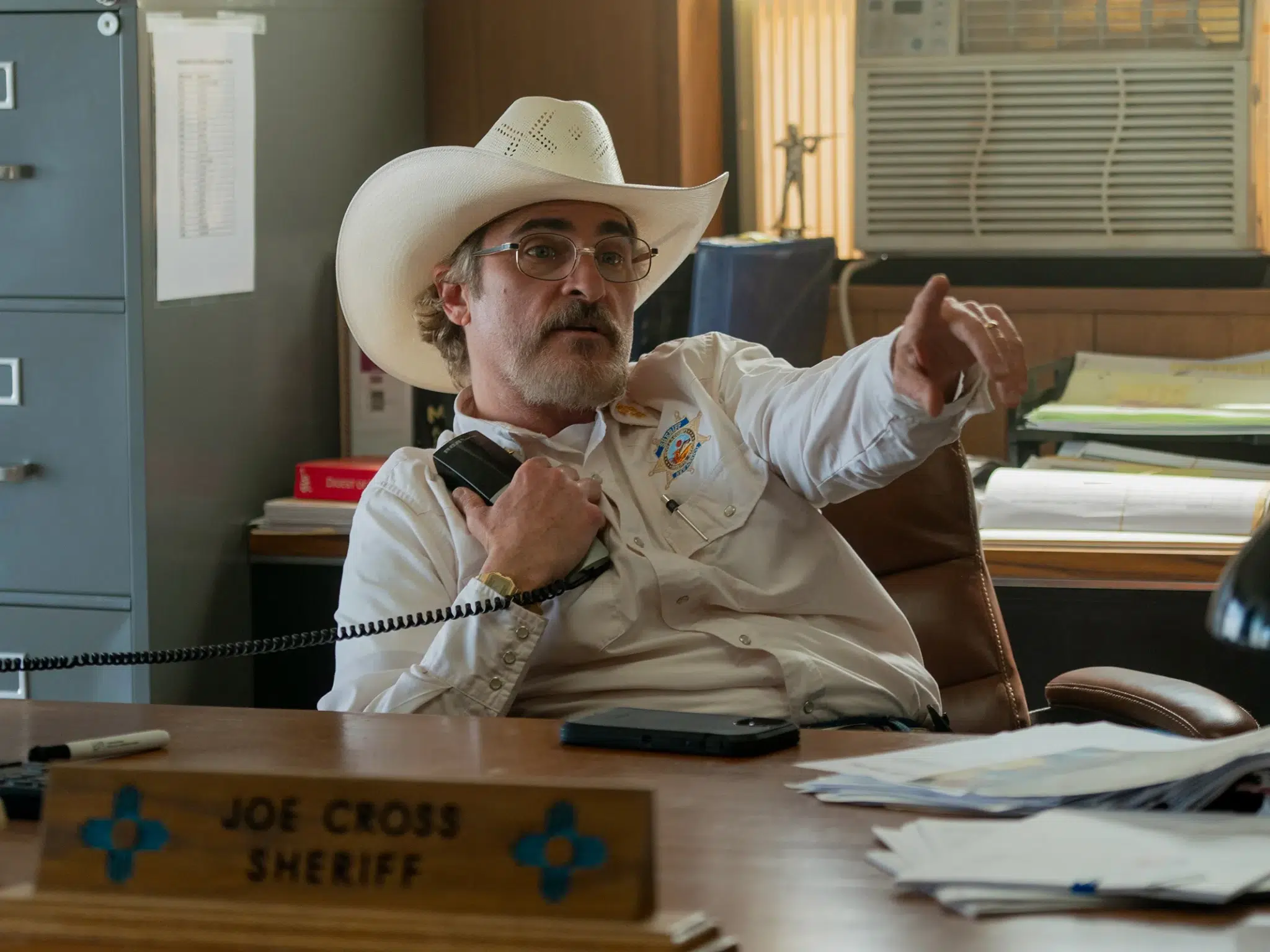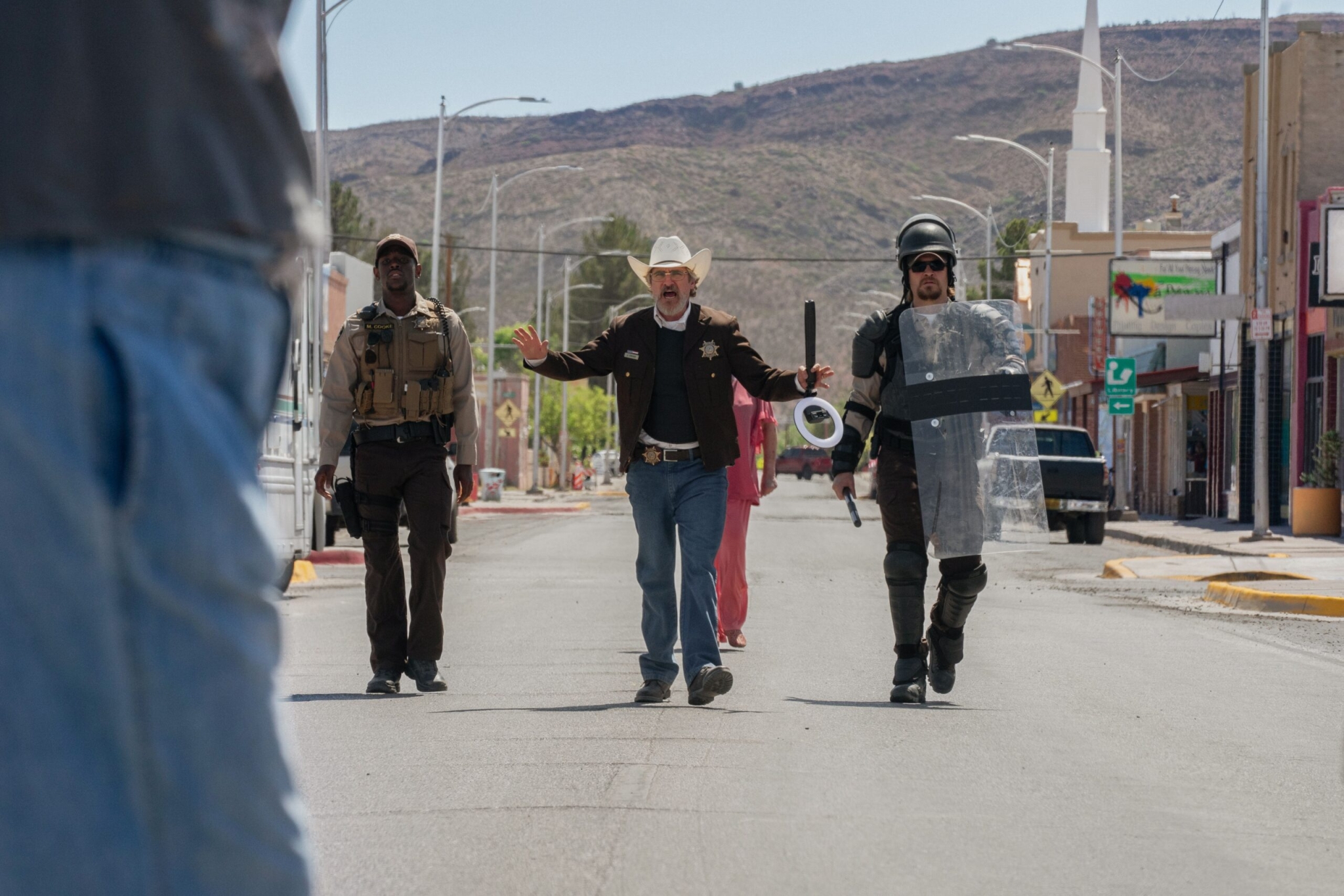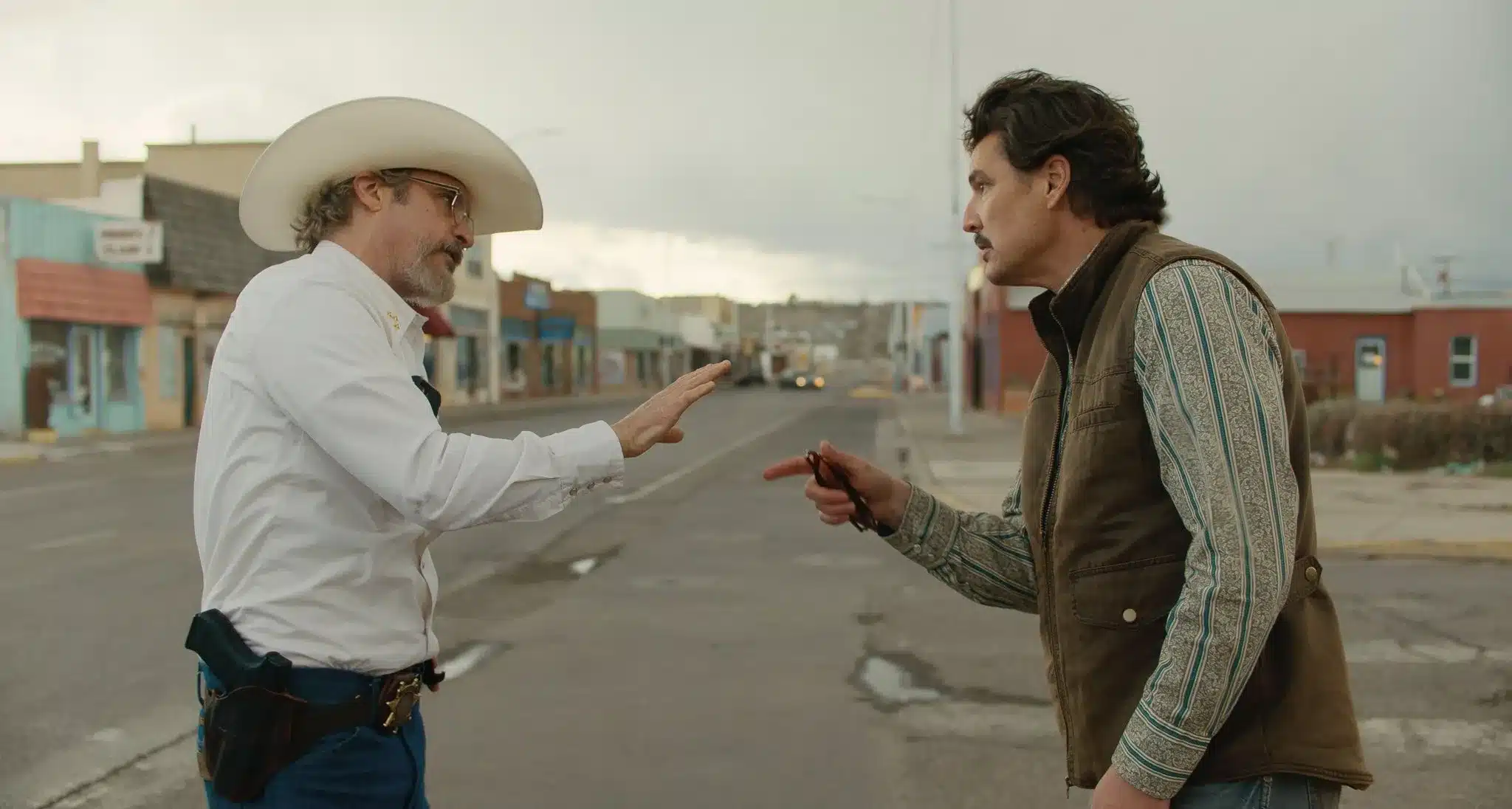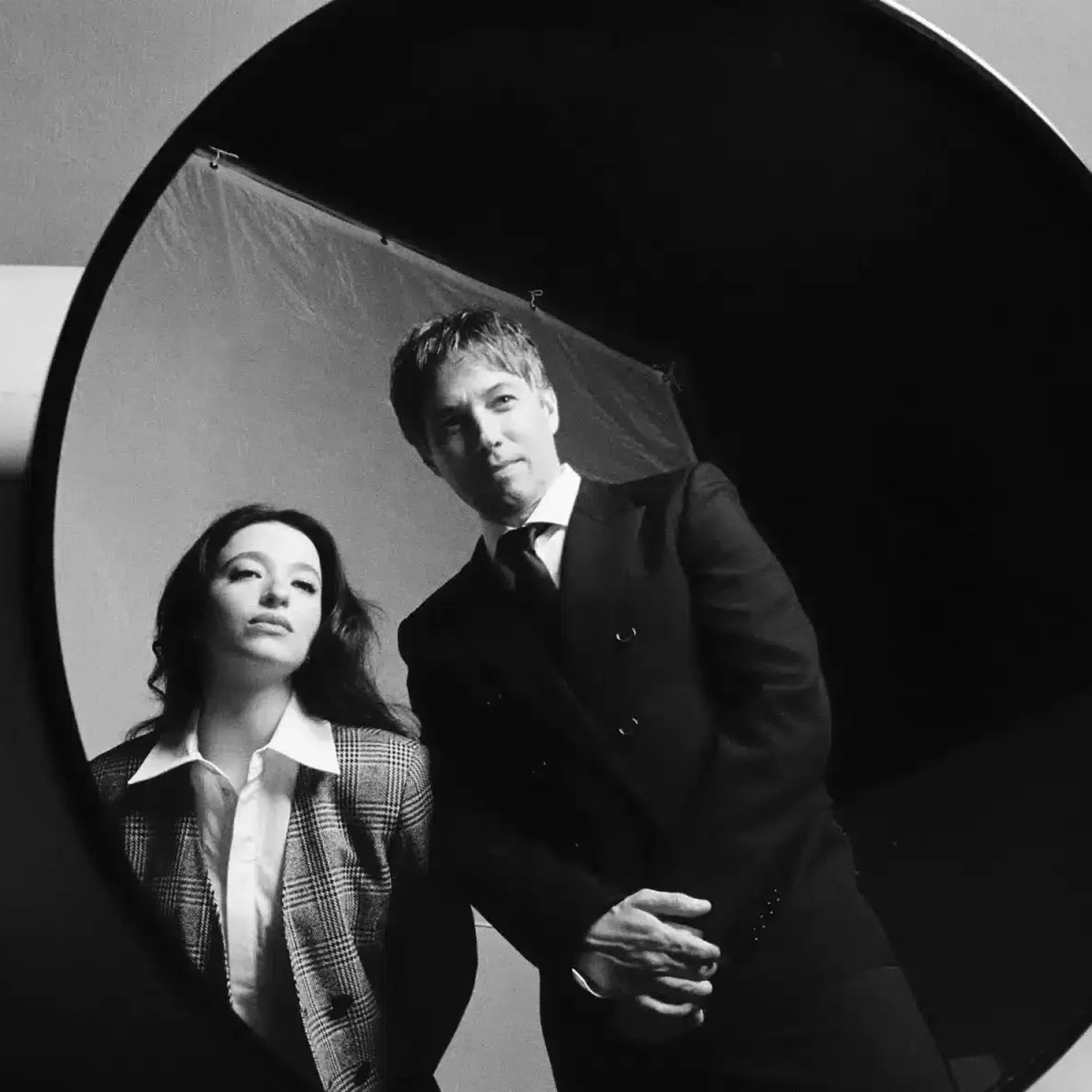
Guest writer Maxime Toscan du Plantier explores the highs and lows of Ari Aster’s Eddington through the lens of the great Greek philosopher Plato.
Eddington, Ari Aster’s pandemic-era Western, is a movie bloated with modern-day (American) anxieties: political violence, racism and social justice protests, conspiracy theories, the growing power of big tech and social media. Set in the early days of the Covid-19 pandemic, the movie explores the rivalry between the sheriff of the fictional small town of Eddington, Joe Cross (Joaquin Phoenix), and its democratic mayor, Ted Garcia (Pedro Pascal). In his previous feature, Beau is Afraid (2023), Aster had already touched on the deeply political themes of homelessness in big cities’ downtown areas – represented rather inelegantly as a horde of violent zombie-like figures – and of the latent violence of the suburban upper-middle class (also explored in Jordan Peele’s Get Out). Just as political, if not more, Eddington has become a proxy for debates about the issues it represents since its Cannes screening, being either praised for capturing the “unreal reality” of May 2020 (by the New York Times) and for being “so close to being nonfiction” (Rolling Stone), or criticized for its cheap shots at white liberal teenagers’ supposedly disingenuous (read lustful) motivations for engaging in social justice protests. Wherever I looked, the discourse centered on the movie’s “realism” or documentary-adjacent depiction of “reality” which heightened the feeling of unease that crept in when I first saw it. As I reflected on this unease, I reverted back to the first line I wrote after leaving the cinema in Cannes: “Plato would’ve hated this film”. Though I do not pretend to speak in the Greek philosopher’s name, his work is as relevant as ever when thinking about the modern debate on the accuracy or truthfulness of artistic representation. This debate is, in fact, as old as discourse on art itself.
As early as the fifth century B.C., Plato was writing about the powers and dangers of representation, in an era when it pertained mainly to poems, sculptures and painted vases, rather than to cinema and modern visual arts. Regardless, his teachings can help us better grasp the substance of the debate over Eddington’s relationship with reality. Indeed, in Plato’s terms, I believe that Ari Aster came dangerously close to being a sophist. In Ancient Greece, sophists, who claimed to have a wealth of knowledge, roamed the lands to teach rich men the art of rhetoric for a handsome price. Their main focus was on helping the pupils argue anything, regardless of truth or conviction. Sophists, Plato wrote in the eponymous dialogue, are hard to define precisely, but their nature reveals itself progressively through examination. Eddington, I suggest, is ripe for such an examination.
In the first hour and a half of Eddington, Ari Aster eschews the surrealist nightmarish approach which characterized Beau is Afraid for a more realistic cinematography. The intent to ground the audience in a feeling of reality is first conveyed in the opening title: “Late May, 2020”. None of us need the title to date the events depicted in the movie, the beginnings of the lockdown and mask mandates are easily recognized. In the historical drama genre, in which it is common to open a movie with a date, this trope serves not only to situate the movie’s events but also to anchor them in our history and our reality. In so doing, the director implicitly ensures the audience of their historical good faith, in the same way that Star Wars’s famous first lines “a long time ago in a galaxy far, far away” signal the fictional nature of the movie to come.

“The movie’s nearly too-close-to-truth quality is furthered visually by Aster’s use of what literary critic Roland Barthes called the “reality effect”: small insignificant details or objects that anchor the fiction in our world.”
Maxime Toscan du Plantier
Then, in one of the movie’s first scenes, Joe gets into a confrontation with the local supermarket’s customers and staff over his refusal to wear a face mask. The scenes feel all too real, and are a striking reminder of the videos that circulated on our social media feeds during these early days of the pandemic (“Costco Customer Gets Kicked Out Of Store For Refusing To Wear A Mask”, “Karen Refused Service for Not Wearing Face Mask Calls 911” etc.). Aster is particularly skilled at reproducing the different discourses of that era: the dialogues all feel strikingly familiar. This is particularly true of the conspiracy theorists’ talking points, which were written after the meticulous research Aster conducted on social media and conspiracy theorists’ websites during Covid-19, as he told WIRED.
The movie’s nearly too-close-to-truth quality is furthered visually by Aster’s use of what literary critic Roland Barthes called the “reality effect”: small insignificant details or objects that anchor the fiction in our world. An early example of this is a shot of Joe’s car passing a green town limit sign that reads “EDDINGTON – POP. 3,135”. The sign uses the same color and typography as real-life US town signs, instantly recognizable, everyday life objects, which gives the scene an air of reality. This reality-effect is most salient in the movie’s use of technology and social media. Phone and computer screens are shown on-screen, with Aster choosing to use their real-life interface: we see characters unlocking their iPhone and removing the airplane mode, scrolling on their Instagram feeds, watching Youtube and commenting on Facebook posts. The sound design also integrates the universally-known iPhone alarm, as well as other ringtones and notification sounds which we know all too well. All of these details create a sense of visual, auditory and affective familiarity which tells the audience it is our world being depicted on screen.
For all these reasons, Eddington is not a satire. Satire as a genre relies on depicting a world that resembles ours but differs in some ways. It is thanks to the slight gaps introduced in satire that we can reflect on our own world and practices. In Don’t Look Up (2021), it is a comet, not climate change, that is threatening life on Earth, and it is this very discrepancy between our reality and the movie’s which allows us to fully see the absurdity of our own inaction. In Eddington, there is no distance. Aster simply gives us a reduced, concentrated version of May 2020 in the form of a two hours and a half movie. Like Pygmalion, Aster seems to have tricked himself into forgetting the artificial nature of his creation. His attempt at a recreation rather than a satire is not bad per se, the real problem comes with the unacknowledged dissonance introduced by the final act.
Indeed, as the movie progresses, the growing tension between Joe and Ted, as well as the breakdown of his relationship with his wife Louise (Emma Stone), sends the sheriff into a spiral of anxiety and madness. As it reaches its climax, Joe’s anxieties coalesce around a group of mysterious black-clad protesters, who first appear in his social media feed, right after Louise leaves him, in the form of a video where a group of them is seen shooting at policemen with rifles. The video’s description reads “Portland Police Precinct, Courtesy of George Soros and ANTIFA!!!!”. With these images, Aster represents a real-life antisemitic conspiracy theory according to which the Hungarian-American billionaire trained and paid protesters (the “antifa”) to turn Black Lives Matter protests into violent riots. Some small-town sheriffs actually believed this theory spread on social media, the Guardian revealed, to the point of preparing for completely imaginary “antifa buses” coming to rural America to wreak havoc. At first, it seems that these masked antifa will remain a figment of the social media algorithm or, at most, a rhetorical device, as Joe blames them in the conspiracy-fuelled press conference he holds to cover up his crime. Up to this point, the antifa scenes are infused with an element of critical distance, as they are shown via character’s screens, and we witness Joe hypocritically wielding these anxieties to blame the murders he committed on an easy target.
“This is precisely what Plato warned us about when he criticized the sophists. Like them, Aster creates images and discourses which purport to be accurate but then uses this credibility to bring outlandish conspiracy theories to life on screen without any critical distance.”
Maxime Toscan du Plantier

To my great astonishment, however, the following scene shows a private plane – with a logo on the tail showing a hand grasping a globe, a heavy-handed nod to conspiracy theory iconography – in which we see the very same black-clad “antifa terrorists” being shipped towards Eddington by a powerful but unidentified billionaire or organization. This scene marks the starting point of the movie’s final act, in which Joe’s fears jump from his mind to the screen in the form of unmediated characters. The antifa murder various police officers and engage in a shooting sequence from which Joe barely survives after suffering a gruesome injury (at this point, the audience of the midday screening in Cannes was laughing out loud). After nearly an hour and a half of unwearying work to establish a realist aesthetic and narrative, which goes so far as to use real-life news reports about the death of George Floyd, nothing in the cinematography signals the imaginary nature of these murderous characters. The movie also seems to retrospectively sanction Joe’s murders: if the “antifa” he is trying to frame for his actions actually exist, and are as violent and ruthless as Aster made them out to be, then wasn’t he, in some way, justified? The lack of indication that such events, while they embody anxieties of the time, never took place, when the movie has done so much to convince the audience of its realism, is shocking at best and problematic at worst.
This is precisely what Plato warned us about when he criticized the sophists. Like them, Aster creates images and discourses which purport to be accurate but then uses this credibility to bring outlandish conspiracy theories to life on screen without any critical distance. In his definition of the sophist, Plato insists on the fact that they knowingly engage in the creation of “simulacra”, of things that pose as truth when they are actually deception. It is in this aspect that Aster differs from other film-makers dealing with real-life events, and even from conspiracy-adjacent narratives such as Oliver Stone’s JFK (which Aster mentions as an inspiration in a Letterboxd interview). Stone, it seems, believed that his revisionist narratives of American history were truthful, and did not shy away from the political consequences of the images he was producing. Conversely, by putting his “masked antifa” in the midst of Joe’s anxieties, Aster maintains a form of plausible deniability, which allows him to reap the rewards of engaging with serious political issues, without having to reckon with the responsibility of what he is filming.
In an interview with Time magazine, Aster presents this choice as a conscious one. The antifa, he says, have to remain anonymous, ambiguous and suggestive, so that democrats can interpret the scene as a GOP-funded false flag operation, whilst “the other side” can spot Soros’ hand behind it all. What revolted Plato the most about sophists is that they could argue anything and its contrary in order to fit their audience’s expectations, regardless of truth or their own convictions (if they could be said to have any). Aster’s final act is not only purposefully unclear and conspiracy-mongering, it also grounds itself in rhetorical arguments that lend it a baseless and dangerous aura of truth and substance in our world. In light of this, and despite the undeniable qualities of the movie’s first half, one can see why Plato would, indeed, have hated Eddington.





